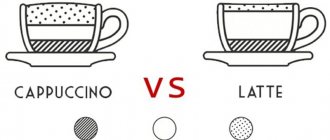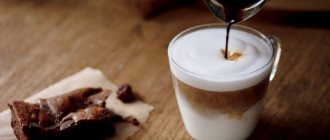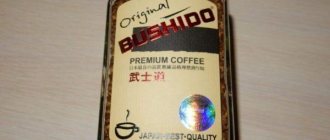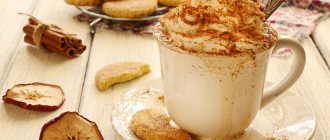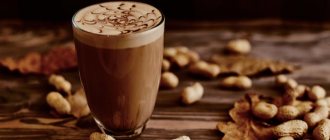Unlike espresso, cappuccino coffee has a mild sweetish taste, without the bitterness characteristic of the base. Warmed cow's milk, an essential ingredient in the classic recipe, produces a similar effect. When the temperature required for cappuccino is reached, lactose breaks down into simple sugars and adds sweetness. We tell you how to achieve the taste at home, in what proportions to use the ingredients and whether it is possible to follow the brewing technology outside cafes and coffee shops.
What is cappuccino
A classic cappuccino is a coffee made from milk and a double shot of espresso. The milk is heated to the required temperature and foamed with steam, after which it is combined with the base.
You can recognize the drink by its characteristic cap of dense white milk foam.
The ratio of components in the traditional Italian method of preparation is 5 to 1. In Russia and the world, it is more often prepared from equal parts of espresso, milk and milk foam.
It is not easy to prepare this variety without a coffee maker and a cappuccino maker, but it is possible. The result directly depends on adherence to technology, proportions, quality of milk and espresso. Before cooking, you should carefully study the theory and select good ingredients.
Cappuccino ingredients and calories
You can prepare a delicious drink at home if you know all the features and the presence of important ingredients. The drink is prepared from the following ingredients:
- Cream.
- Water.
- Ground coffee.
- Cinnamon.
- Sugar.
There is an opinion that cappuccino is a high-calorie drink, is this true? Let's look at its calorie content per 100 grams:
- 62.2 kcal;
- 1.4 g – proteins;
- 1.9 g – fats;
- 11 g – carbohydrates.
This dosage of the drink is enough to enjoy its taste and feel the real aroma, without gaining excess weight.
During the preparation process, preference is given to pasteurized milk, which easily whips into foam and helps create an aromatic and tasty drink without the use of additional additives.
Cappuccino is prepared in a coffee machine or without it, using improvised means. Both options allow you to prepare a tasty and aromatic drink, while enjoying it it is difficult to guess the technology for its preparation.
If you don’t have a special coffee machine at home, don’t despair. The technology allows you to quickly and tasty make cappuccino, relying on the basic rules of its brewing.
In the coffee machine
Preparation in a coffee machine is a standard and convenient method for cafes and restaurants where there is a large flow of people. To prepare cappuccino, you must follow the following procedure:
- First you need to brew regular coffee according to a standard recipe using a coffee maker.
- Next, the coffee machine warms up for 30 minutes, releasing the resulting steam from a special tube.
- Take a metal container and add milk to it, leaving 1 cm to the bottom of the spout. This is necessary so that during the boiling process the milk does not escape from the container.
- Then the tip of the cappuccino maker is immersed in the bottom of the milk container, the steam is turned on and a small foam is formed. When prepared correctly, it will have a pleasant sweet taste.
- The milk foam is poured into the coffee slowly and in one line.
- Next, steam is released and the tip of the cappuccino maker is wiped.
To make a perfect cappuccino in a coffee maker, it is important to choose real coffee and use only cold milk with a fat content of 4%. Only this will allow you to create a beautiful and sweet foam. The brewed cappuccino will be tender, tasty and appetizing.
If there is no special coffee machine in the house, this does not mean that making cappuccino is in doubt. It can also be prepared using a Turk, if you follow all the recommendations and the sequence of work correctly. The cooking technology is as follows:
- First you need to brew regular coffee in a Turk, adding a little sugar to it to taste. To do this, place a dry coffee mixture and a spoonful of sugar into not very hot water. It is important to cook it correctly; it should not boil. As soon as its cap rises slightly, you should immediately remove the coffee from the heat. To make the coffee richer at the end of preparation, you need to raise it above the heat for a few seconds and lower it back down. Such manipulations are carried out 3–4 times.
- The finished coffee is set aside and we move on to preparing the milk. To do this, you need to heat it in a separate container; it is convenient to use a microwave. Next, the heated milk is poured into a capacious container and whipped into foam with a mixer. The hat should have a thick consistency.
- The prepared and slightly infused coffee is poured into a container from which you can drink the finished drink. You only need to pour coffee up to half a glass or cup.
- Next, foamy milk is gradually poured into the same container without stirring. When there is a little foam left in the milk glass, you need to transfer it with a spoon into a container with the drink and draw a beautiful design with a toothpick. Top with dark grated chocolate for taste.
How the drink came about
The official history of cappuccino begins in the 20th century. It was then that the name was assigned to a drink made from cream and coffee with pronounced foam. Italy is considered the birthplace of drinking, but similar varieties were found before, in other countries.
The “progenitor” of the drink was the Austrian version made from coffee, cream and yolks. Back in the 18th century, the mixture of ingredients began to be called the Italian word cappuccino, which translates as “capuchin”. At the time the variety was created, the Capuchin order was popular, whose members wore robes of a similar red-brown color.
According to another version, the name is associated with nasturtium flowers. The shape of the porcelain cups for serving the drink resembles red-orange capuchins.
In Russia, the name of the drink was fixed in the form of “cappuccino”. Other variants that retain double “p” and “h” are also less common. However, the spelling when choosing between cappuccino or cappuccino advises choosing the second option.
What's included
Unlike instant coffee with foam with a dozen ingredients, the drink from coffee shops includes 2 components: espresso and milk. When choosing a standard recipe and following the cooking technology, the calorie content reaches an average of 400 kcal.
The first is preferably brewed from freshly ground grains with a classic taste - Arabica or a blend of Arabica and Robusta. Brazil Santos, Caruso, Honduras go well with sweetness.
Ready-to-cook, factory-made powder is not suitable.
Roast the beans yourself; medium and dark roasts are suitable.
To prepare this variety, you need to take care of the choice of milk. A dense, stable foam is produced by a product with an average percentage of fat content and a high protein content - more than 3%.
It should be natural milk without adding powder. An UHT or pasteurized product is required.
If you don’t know how to choose the right one, try making a drink with Riobo 3.5% milk or “Molochnaya Rechka” “For cappuccino”, Valio “Otbornoe”.
Before whipping, the product must be cooled to 2-6°C.
If you plan to make cappuccino at home without a coffee machine, take cream - the product is easier to froth.
Ingredient Selection
To make a delicious cappuccino, you need to choose the right milk. It should not be powdery - only natural. And not any low-fat. Only 3.2% and above. Take 100 – 150 ml per serving.
For you:
Recipe for warming and piquant coffee with cognac
To get the right consistency, it's a good idea to use a kitchen thermometer. Since the desired texture can be achieved only at 60 - 65 oC. In this case, lactose is broken down into galactose and glucose, and because of this the milk becomes sweet.
The dishes in which the cappuccino will be served are also important. The cup should have a volume of 140 - 170 ml. A 120 ml version from a home service is also suitable. The cup is wide at the top and tapering towards the bottom.
Important! The cup should maintain the temperature of the drink for a long time, allow the foam not to fall off and not burn your hands. Therefore, the best materials for such dishes are porcelain, ceramics and clay.
There are two rules for pouring cappuccino into a cup:
- Coffee and milk should completely occupy the volume of the dishes.
- The foam from the milk rises at the edges.
Classic drink recipe
Before cooking, stock up on:
- 60 ml espresso;
- 60 ml cold milk for whipping or cream.
Take a ceramic cup with a volume of 180 ml or more. Warm up the dishes with steam, pour in the coffee. Heat the milk to 60-70°C. Froth the liquid using a cappuccino maker until a dense, fine foam forms. Ideally, the surface should be glossy, like glass.
Gently pour the milk into the base. If the technology is followed, the mass will be divided into layers. A mixture of coffee and liquid milk will remain at the bottom, and the foamed part of the latter will remain at the top.
In coffee shops, the ready-made version is often served with cinnamon sprinkles or designs on the “cap,” which become the subject of photos and videos on Instagram and help promote the establishment.
How to make cappuccino at home
It is much more difficult for an amateur to achieve the same taste and aroma as professional baristas. You will need:
- 2 tsp. freshly roasted and freshly ground grains;
- 100 ml water;
- 100 ml milk;
- a Turk and a cup for heating milk;
- French press or mixer.
Place the coffee in a pot, add water, and stir. Place on low heat, wait until a “cap” of foam appears, remove the pan from the heat. When the foam settles, return to the stove. Repeat 2-5 times, achieving the usual taste. Set aside so that the coffee particles settle to the bottom.
Heat the milk until the liquid burns the skin, but do not boil. Whisk hot using a compact whisk or French press, quickly raising and lowering the filter. Pour the coffee into a cup and pour frothed milk on top.
Combining coffee with foam
In order for you to get a cappuccino, and not just coffee with added milk, the latter needs to be whipped into foam. You already know about the required temperature and fat content, now let’s talk about the process.
Important! In addition to the fat content of the milk, you need to look at the protein content in the composition - it should be more than three percent.
You can froth milk manually or using various kitchen appliances.
French press
If you have a French press, use it:
- Heat the milk to the desired temperature.
- Move the handle up and down sharply several times (until you get the result).
- Pour the foam into a cup.
By the way! If you really like cappuccino, you can buy a frothing jug. They come in different sizes, so you can choose the right one. You can also make cocoa and hot chocolate in them.
Using a mixer or immersion blender
To beat, you can use a mixer or immersion blender:
- Pour milk into a saucepan and place on low heat.
- Lower the device into it and start beating at low speed.
- Bring the milk to the required temperature.
- Pour carefully into a cup.
Important! Pour milk into the container to a quarter of its volume so that it does not run away when whipping.
Instead of such large devices, you can purchase a small frothing blender. As a rule, this device copes well with small volumes of milk and produces stable foam.
Hand mixer or whisk
You can whip the foam by hand - with a whisk or hand mixer. This process will take longer and does not guarantee a good, stable foam.
For you:
American coffee: choice of beans, grinding, technology
You also need to froth the milk during the heating process, without bringing it to a boil.
How is cappuccino different from latte?
The main ingredients in latte and cappuccino coffee are similar, but the options have 4 fundamental differences.
- Proportions of coffee and milk in the recipe. Cappuccino is often prepared from equal parts of ingredients. A latte requires one part espresso and two parts milk.
- Taste. Due to the higher espresso content in cappuccino, it has a relatively pronounced coffee taste. Lattes are characterized by delicate, creamy notes.
- Milk foam. The drinks do not differ in the size of the foam cap. However, cappuccino has denser and finer foam, while latte has airy and light foam.
- Serving. A classic cappuccino is served in small round cups. Dishes are most often made from porcelain. The volume does not exceed 180 ml, for a double portion – 360 ml. Lattes are served in clear glass glasses that allow you to see the layers. Utensils usually have a foot and a handle for convenience. Glass volume – 240-360 ml.
The drinks also differ in appearance. Cappuccino has 2 layers: liquid coffee and milk part and foam. Latte is divided into 3 parts: milk, espresso and foam with smooth transitions from one color to another.
When and with what to use
When? In Italy it is not customary to drink cappuccino after lunch. But in Western Europe, on the contrary, they consider it exclusively an evening, romantic drink. In America, people drink cappuccino throughout the day.
Most likely, the Italians are right - cappuccino contains caffeine, which is preferably consumed in the first half of the day.
How? It is customary to serve cappuccino in a warmed cup with a volume of 150-180 ml and drink it immediately. In fact, strict volume rules are no longer followed, especially when the drink is prepared at home.
You need to drink the cappuccino all at once, that is, combine both layers in one sip - both the foam and the coffee. The foam above your upper lip is a sign that you are doing everything right.
Traditionally, cappuccino is drunk without sugar. If you do not overheat the milk, its natural sweetness is considered sufficient.
With what? Due to the fact that two-thirds of the drink consists of milk, a rather heavy product, cappuccino is not drunk during or immediately after a meal.
The best accompaniment to this drink is fresh baked goods - light buns, fluffy croissants, sweet donuts. Crispy cookies and delicate desserts - tiramisu, brownies - go well with cappuccino, but do not forget about the calorie content of the drink.
Content
Already on the fire, you should start whisking the milk with a whisk. As a rule, the result is achieved within 40 seconds. You can check the stability and uniformity of the “cap” by scooping it into a spoon and turning it vertically. The optimal milk temperature for cappuccino when whisking by hand is 60-65⁰. An overheated product loses the desired aroma and taste. And if the temperature is lower, the foam will be loose.
The order of mixing the ingredients is as follows:
- Hot espresso is poured into the cup.
- Sugar is added and mixed.
- 15-20 ml of warm milk is poured.
- A beautiful foam cap is laid out. The top can be sprinkled with cinnamon or cocoa.
With instant coffee
This method cannot be called classical, but it is ideal in conditions of an intense rhythm of life. Prepare regular instant coffee: pour 1 teaspoon of granules into 50 ml of boiling water. Milk heated over low heat can be quickly whipped using a regular mixer. The main condition: you need to turn the device on and off when the whisk is immersed in liquid. When the structure becomes smooth and uniform, the foam is spooned over the drink.
Life hack: if you preheat the cup in the microwave, the cappuccino will stay hot longer.
You can make the taste of the instant drink softer with caramel or berry topping. It is poured in front of the “cap”. The result is a beautiful, invigorating cappuccino without a coffee maker or Turk.
Original with egg foam
Hot espresso is poured into the cup, followed by 30 ml of warm milk. Spoon the beaten egg whites into a small heaped spoon. With such a thick “hat” you can experiment with creativity. The easiest option at home is to sprinkle cocoa and draw a pattern of powder on it.
Sticky vanilla
This unusual way to make cappuccino in a Turk at home will appeal to gourmets. First you need to brew classic coffee in a Turk. Espresso should not contain grounds, so the remaining ground beans should always be strained.
A special foam is prepared separately. Only the yolk is extracted from the egg and it begins to foam. You can do this with a homemade shaker. Its role will be played by an ordinary glass jar with a tight lid. Vigorous shaking will do the same thing as a whisk or mixer. Immediately add 2 teaspoons of powdered sugar and two pinches of vanillin. Beat the mixture thoroughly.
Next, 50 ml of cream with a fat content of 30% is added to the “shaker”. Now you need to shake the jar until a thick, viscous foam forms. The liquid sediment is poured into the cup. Finally, egg-cream foam is laid out. This method is a little longer and more complicated than the classic one. But such an original treat at home will surprise even the most demanding guests.
Content
The benefits and harms of the drink
Drinking cappuccino often has a negative effect on the body:
- causes drowsiness. Milk reduces caffeine concentration. Instead of the expected cheerfulness after a cup, you can get the opposite effect;
- increases the risk of developing stomach cancer. The main components conflict, in combination they neutralize each other’s benefits and form a poorly digestible substance. If you drink frequently and in large portions, part of this mass will “settle” in the stomach;
- blocks the vasodilatory effect of caffeine. If you're hoping to raise your blood pressure with a cup of this drink, you're in vain.
This variety has only one advantage - even those who find espresso too rich and tart will like the taste. The mixture still has strong coffee notes, but the bitterness is masked by the sweetness of the milk.
If you don’t want to harm yourself, choose the right “dosage” – up to a couple of cups per week – or alternate with the classic, undiluted version.
How to serve and drink correctly
Pour the drink into ceramic cups, preheated by steam. The dish, shaped like a round bowl with a handle, is placed on a saucer and served to the client. In the homeland of the variety, Italy, the drink is considered an ideal addition to the morning meal and is consumed along with breakfast rolls.
It is not easy to cook this variety in an apartment, without special equipment. However, it is not necessary to buy a coffee machine. Start by choosing the right raw materials, familiarize yourself with the technology and find a French press or compact electric whisk.


